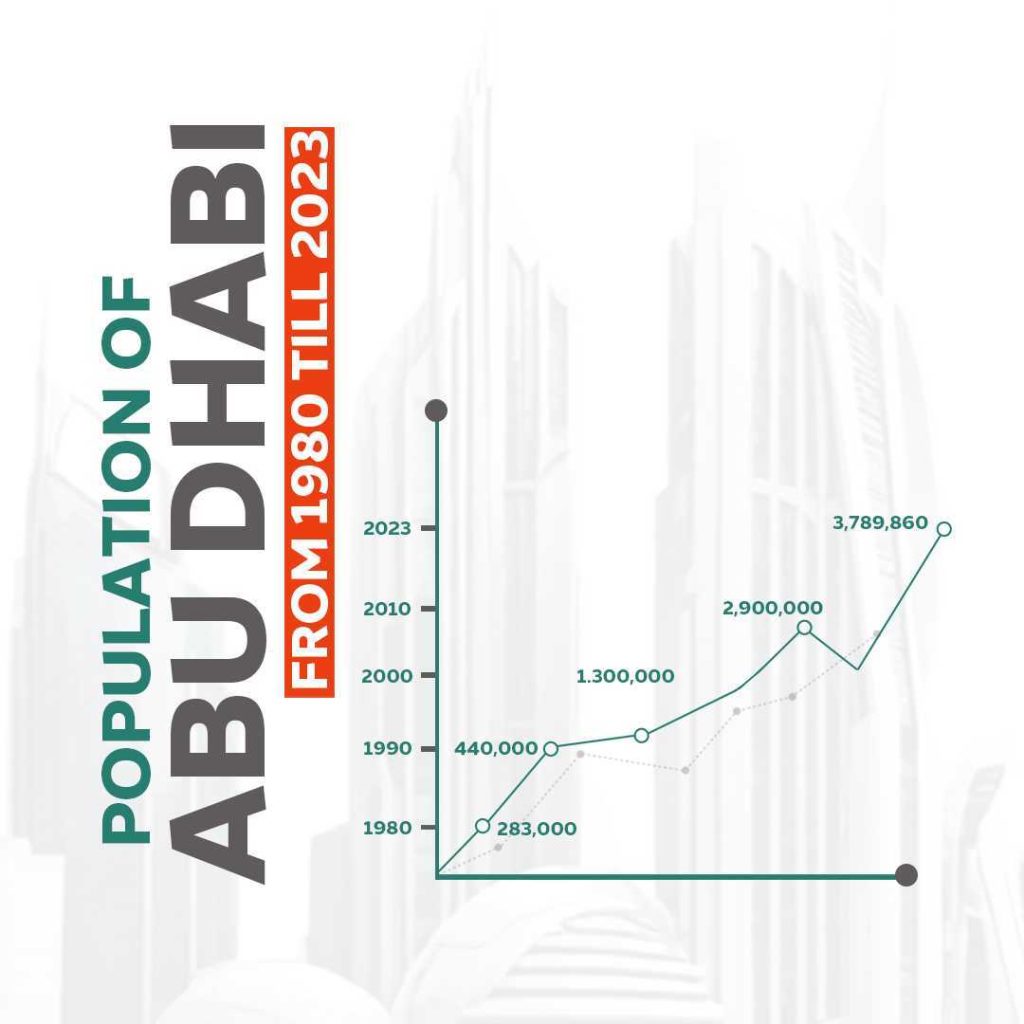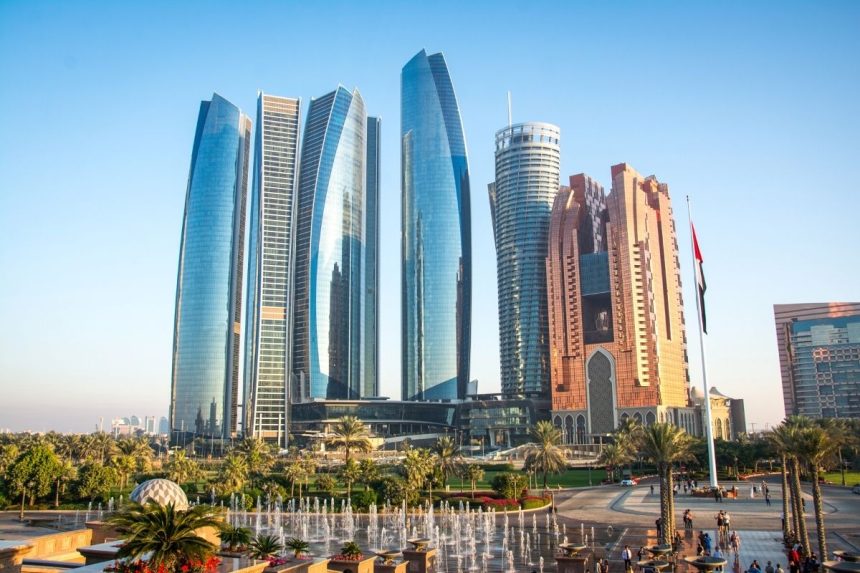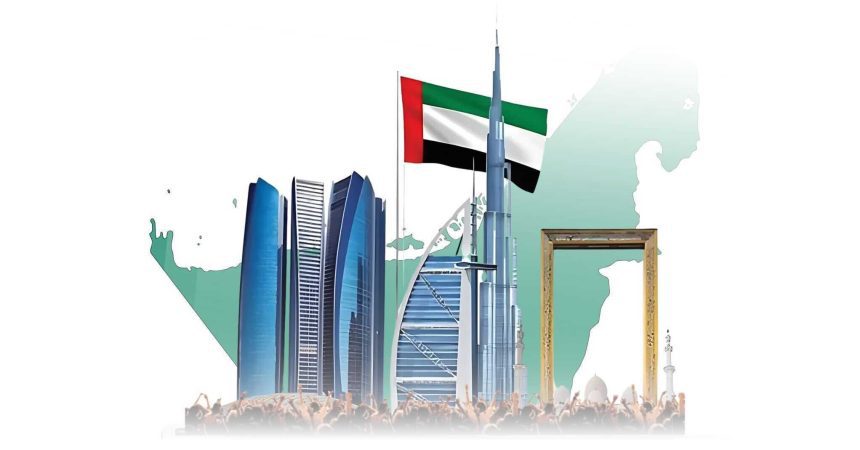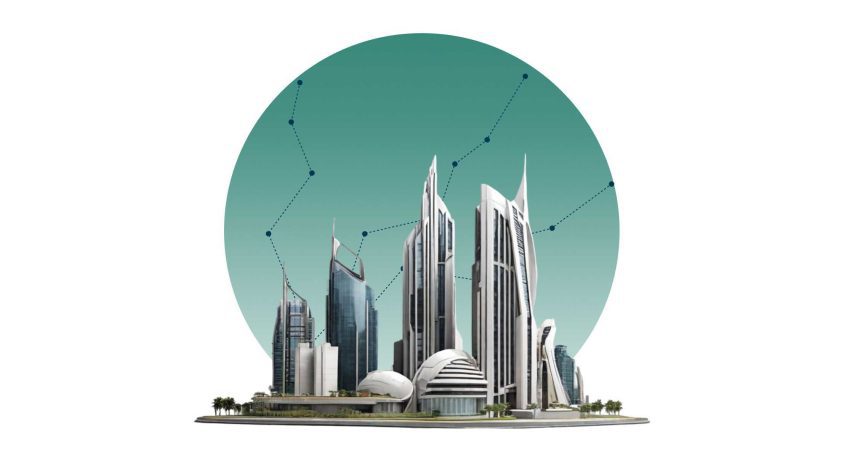Population of Abu Dhabi Makes Around 40% From Total UAE’s Population
As of 2023, the population of Abu Dhabi has reached over 3.8 million.
This number makes up about 37% of the UAE’s total population, estimated at around 10.4 million.
Abu Dhabi’s significant population growth reflects its appeal as a hub for employment, investments, and development.
Due to the large-scale infrastructure projects, economic diversification, and its oil industry.
Abu Dhabi’s government has continued to attract both local and expatriate residents.
Through its huge investments in real estate, healthcare, and public services.
Timeline of Abu Dhabi Population Growth From the 1980s to 2023
In fact, Abu Dhabi has experienced remarkable population growth over the recent decades.
Let’s take a look into a timeline capturing Abu Dhabi’s growth journey:
1980s: Oil Boom and Steady Growth
Due to the oil boom, Abu Dhabi’s population began expanding in the early 1980s.
During that period, Abu Dhabi attracted global workforce, and by 1985, the population was around 283,000.
Because expatriates have moved to Abu Dhabi for the diverse opportunities in the energy sector.
Besides the government initiatives that encouraged development.

1990s: Surge in Urban Development
Abu Dhabi saw continuous growth in infrastructure and urbanization in the 1990s.
In 1995, the population of Abu Dhabi had reached over 440,000.
As the government has led projects to boost housing, healthcare, and transportation, supporting the growing number of residents.
2000s: Accelerated Growth
Abu Dhabi’s population skyrocketed in the 2000s.
As the figure reached nearly 1.3 million by 2010.
Mentioning that economic diversification brought in a large foreign labor force to meet demands in new sectors.
Such as tourism, real estate, and finance.
This period marked a shift from a predominantly oil-based economy to a more diversified one.
2010s: Continuous Population Expansion
In the 2010s, Abu Dhabi population growth remained robust.
It reached 1.8 million by 2015 and approached 2.9 million in 2020.
The strategic focus on economic diversification attracted more expatriates.
While the healthcare, education, and tourism sectors grew and cemented Abu Dhabi’s position as a leading Middle Eastern hub.
2023: Modern Milestone of 3.5 Million Residents
According to the SCAD Abu Dhabi Census 2023, the Abu Dhabi population has reached around 3,789,860 people.
This impressive number marks an 83% increase since 2011.
Males make up 67% of the total population (2.54 million).
While females constitute 33% (1.25 million).
Abu Dhabi City remains the most populous area with 2.5 million residents.
Followed by Al Ain with 1 million and Al Dhafra with 284,205.
Workforce and Residential Growth
The employed population has expanded by 82% since 2011, totaling 2.52 million.
Due to the economic growth and the shift of Abu Dhabi toward a knowledge-based economy.
White-collar workers represent 46% of the workforce.
They have increased by 109% since 2011.
While blue-collar roles grew by 65%, showing the city’s workforce diversity.
Residential and non-residential units also grew by 66%.
Now their total is 754,555 units, reflecting sustained infrastructure investments and urban development.

Future Development and Strategic Vision
Abu Dhabi’s government is implementing comprehensive plans to meet the needs of a growing population.
With the support of census data.
This population growth underscores Abu Dhabi’s evolution as a dynamic business, investment, and lifestyle destination.
Aligning with its vision for sustained growth and economic diversity.
In 2023, $4.4 billion was invested in the development of Abu Dhabi.
Abu Dhabi Projects and Infrastructure Centre has developed 80 projects to improve the infrastructure of the UAE capital.
71 projects were completed last year, including:
- 9000+ Housing Units
- Parks, Schools, and Community Centers
- Zayed Port Tunnel
- Road junction at Zayed International Airport
- Umm Yafeenah Bridge, etc.

Expected Growth for Abu Dhabi Population
Over the next decade, Abu Dhabi’s population is expected to grow significantly.
Due to the emirate’s appeal as a global business and lifestyle destination.
The “Economic Vision 2030” and similar initiatives aim to boost Abu Dhabi’s economy.
By reducing reliance on oil and expanding sectors like tourism, healthcare, finance, and technology.
The UAE government has also launched new visa schemes to attract highly skilled professionals, entrepreneurs, and investors.
Such as the Golden Visa and remote working visas.
These policies can bring an influx of international talent, increasing the population by around 1-2% annually.
The UAE has proven its leadership in the global energy sector, as one of the most prominent producers of bioenergy, which has taken qualitative steps in the energy transition phase and is among the leading countries in the green hydrogen production scene and dealing with critical… pic.twitter.com/sFOd5mS6bt
— UAE Voice (@uae_voiceeng) November 6, 2024
Also, the large-scale residential, commercial, and infrastructural projects will continue to attract new residents.
Some projections estimate a population of over 5 million by 2033.
Abu Dhabi’s median age is currently around 33, a relatively young population.
This supports natural population growth and the likelihood of younger families settling in the emirate for the long term.
If these trends continue, Abu Dhabi population growth is expected to increase between 20 and 30% over the next decade.





